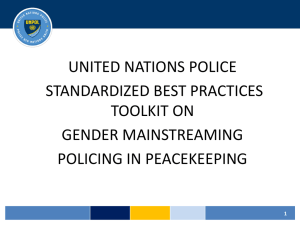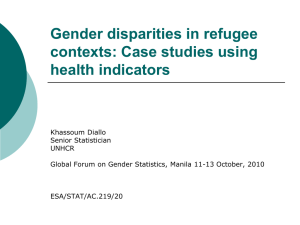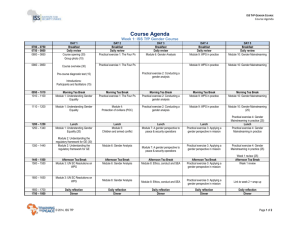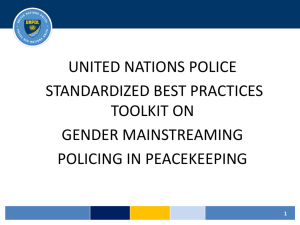Module 3 Lesson 5 SGBV Office (Instructor's PowerPoint)
advertisement
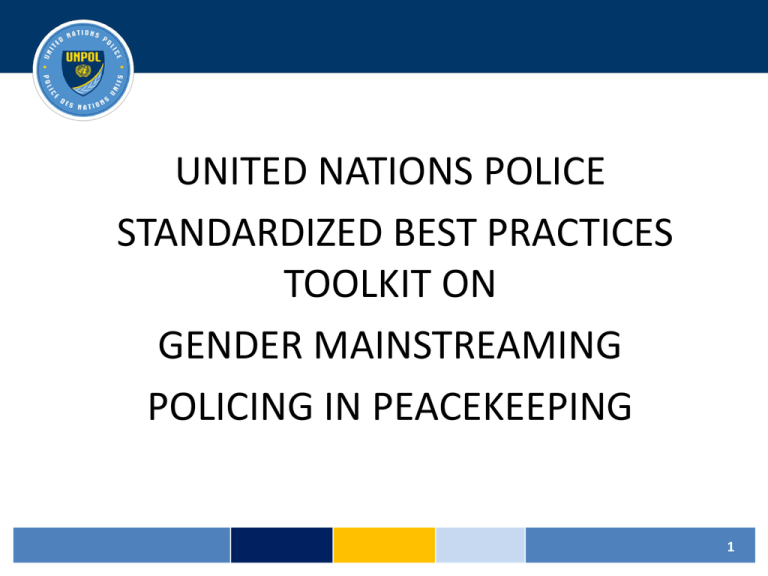
UNITED NATIONS POLICE STANDARDIZED BEST PRACTICES TOOLKIT ON GENDER MAINSTREAMING POLICING IN PEACEKEEPING 1 UNPOL GENDER TOOLKIT MODULE 3 LESSON 5 ESTABLISHING SGBV INVESTIGATIVE POLICE STRUCTURES 2 Learning Objectives Identify the steps for preparing, constructing, operationalizing, and monitoring and evaluating a project to establish a specialized SGBV police unit Produce a concept note and project proposal Develop a strategy and action plan Create a monitoring and evaluation framework 3 Why is it important to have an SGBV investigative structure? 4 Expected outcome Will increase the conviction rate of SGBV offenders Will increase police’s ability to prevent crimes from happening through community engagement and knowledge of victim and offender profiles Why is it important to have an SGBV investigative structure? Can be vital to the investigation of the specifics of SGBV crimes Will encourage victims to report due to increased trust Will decrease revictimization 5 Activity According to the group assigned to you, discuss and enumerate the steps towards accomplishing one of the processes below. Monitoring and evaluating Operationalisation Preparation and construction 6 Expected outcomes Preparation and construction 1. Assess needs 2. Identify partners within the HSP 3. Select a structure 4. Obtain approval 5. Raise funds 1. Negotiate at the local level 2. Initiate procurement process 3. Perform formalization process 4. Manage staffing 7 Expected outcomes Operationalisation 1. Develop an SOP and train officers 2. Formulate a strategy and an action plan 3. Create a data collection system 4. Establish a victim referral network 5. Disseminate information on the SGBV police unit Monitoring and evaluating 1. Understand the process of monitoring and evaluating 2. Develop a Monitoring and Evaluation framework 3. Select indicators 4. Adapt reporting formats to the audience 8 Group Discussion: Challenges 1. Divide into syndicate groups. 2. Debate according to the card you have received from the instructor. You will have 10 minutes. 3. Share findings with the large group. 9 Activity: Project 1. Based on your findings, your instructor will assign your group a different phase of establishing SGBV units. 2. Your group will have 15 minutes to develop the related tools. Preparation and construction Project proposal Terms of reference Operationalisation Strategy Action Plan Monitoring and evaluating M&E framework 3. Share your achievements with the group. 10 Expected outcome: Project Proposal A project proposal is an expansion of the concept note, as well as a request for financial assistance to implement a project 3.2 Timing 3.3 Monitoring and evaluation 1. Issue/problem statement 2. Project description/outputs 2.1 Project description 2.2 Objective 2.3 Activities and outputs 2.4 Expected outcomes 3. Expected outcomes 3.1 Management 4. 5. 6. 7. 8. Risk management Sustainability Detailed costing Contact details Annexes 11 Expected outcome: Project Proposal 12 Defines the vision and mission of the unit, its core functions, and the duties and responsibilities of staff. Expected outcome: Terms of Reference 13 Expected outcome: Strategy A strategy helps plan and organize resources to optimize the achievement of the proposed goals. 14 Expected outcome: Strategy 15 Expected outcome: Action Plan An action plan is a document which lists the steps to be taken in detail to achieve specific objectives. 16 Expected outcome: Action Plan 17 Expected outcome: M&E Framework Expected results Indicators Data collection methods Baseline data Targets Data Sources Frequency Responsibility Reporting A Monitoring and Evaluation Framework helps you identify indicators and how to track them. 18 Expected outcome: M&E Framework Expected results Indicators Baseline data Targets Data Sources What do you want to achieve? What are you measuring? What is the current value? What is the source of data? What is the source of the data? Data collection methods Frequency Responsibility Reporting How is data to be obtained? How often will data be measured? Who will measure the data and what resources are required? How and to whom will information be reported? 19



